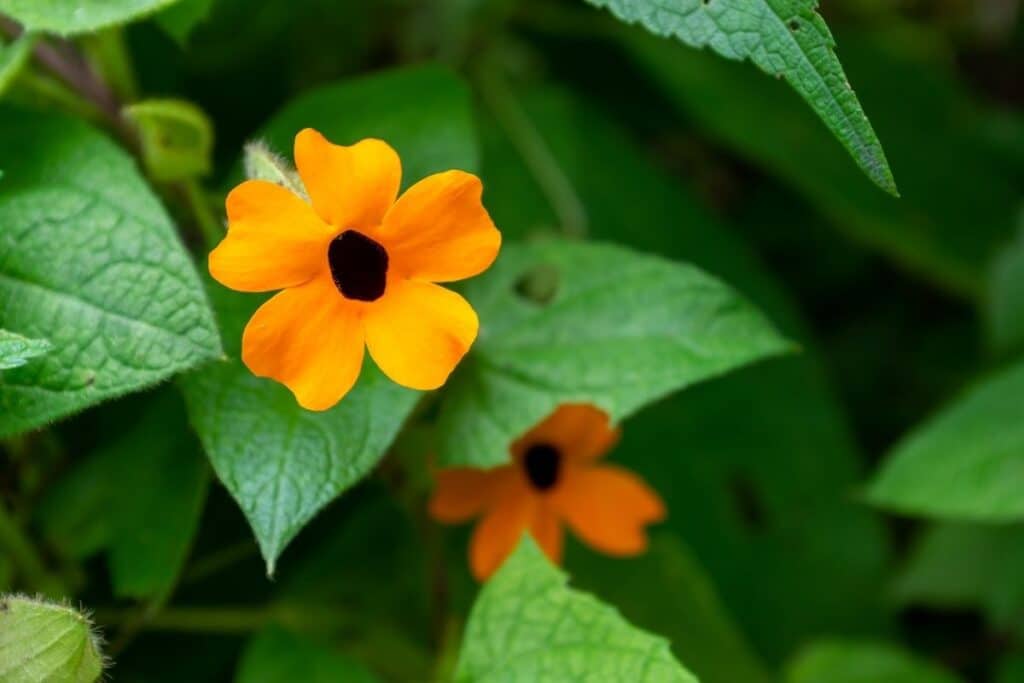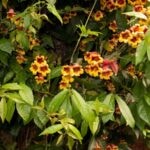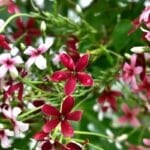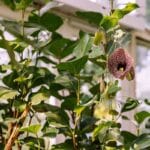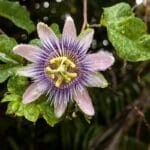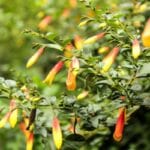Some households have small areas for their garden beds. Fortunately, a beautiful garden is not limited by the availability of its horizontal space. Hence, the birth of vertical gardens. One of the plants that are utilized in vertical landscape designs is vines that are easy to grow and aesthetically pleasing at the same time. The Black-eyed Susan Vine, Thunbergia alata, definitely checks those boxes.
Botanical Information
Thunbergia alata goes by the names Black-eyed Susan vine, black-eye Susan vine, blackeyed Susan, and clock vine. It is a native plant from the tropical climates of Africa, such as tropical Eastern Africa up to the east of Southern Africa.
Often mistaken to be Rudbeckia Hirta or the Black-eyed Susan which is from the Compositae family and is a short-live herbaceous plant. In comparison, the black-eyed Susan vine is from the Acanthaceae family and a tender evergreen perennial.
Given its origin, Thunbergia alata is suitable to be grown in zones 10 to 11. In some locations, this vine is treated as a weed due to its versatility. In the tropics, the plant is visible in areas such as urban bushlands, plantations, disturbed sites, roadsides, forest margins, and waste areas. This proves that this magnificent plant is versatile and grows vigorously. Properly identifying this plant is important to know how you can grow and care for it.
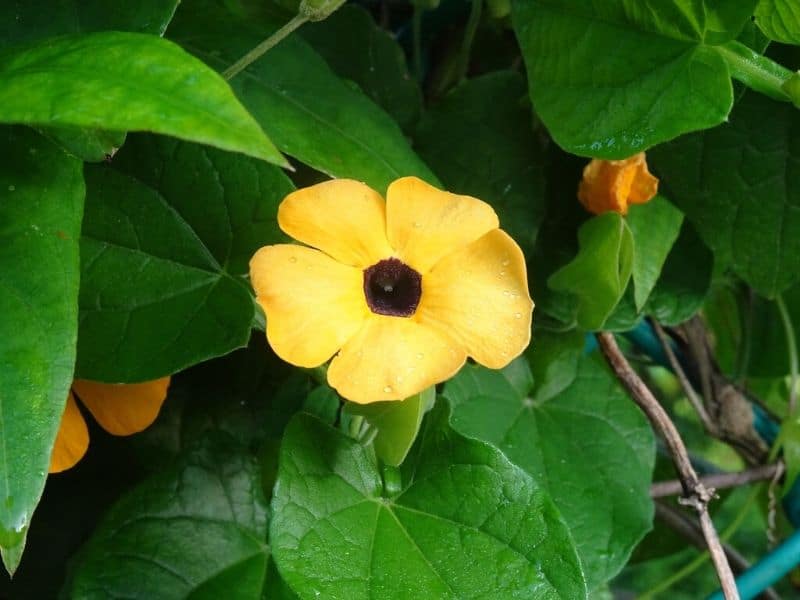
Leaves
At its young age, the stems appear to be slender, hairy, and green. As it matures, the stalks become narrowly winged with leaves on opposite sides. The clock vine’s leaves are characterized by their toothed margins and triangular-ovate or arrow-like shape that extends up to 3 inches in length and 1 to 4 cm wide. Its hairs underneath the leaves, along the veins, are noticeable when touched. However, the upper side of the leaf has little to no hair.
Flowers
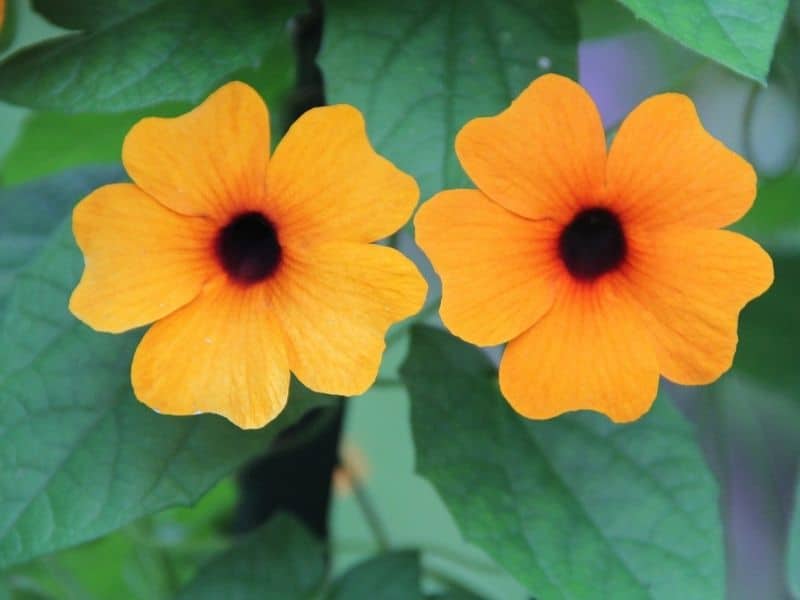
The Black-eyed Susan climber got its name from its flower’s distinct feature. It blooms a black-throated yellow or orange flower with two bracts on the basal part. The flowers usually extend 3 to 4 cm wide, while the bracts are 1.2 to 2 cm in length. Its petals are fused to form a tube-like structure, which is around 1.5 to 2.5 cm long. The flower’s reproductive parts, it is composed of an ovary that has a style and stigma on top and four stamens.
Since the T.alata vine is perennial, it produces blooms all year round. However, its peak blooming season is around early summer and spring.
Fruit and Seeds
The Blackeyed Susan produces globular or rounded fruit pods with seeds inside it at maturity. The fruit capsule has a distinct beak and extends from 0.9 to 1.5 cm. Also, fine hair surrounds the pods. Green is the initial color of the capsules but it turns brown as it reaches maturity. On the other hand, the black eyed susan seeds are chapped and have protuberances.
Growth and Development
During the developmental stages of young plants, the Blackeyed Susan vine has frail green and hairy stems. As it matures, it becomes more vigorous with its woody rootstock and vast growth of stems. This vine can extend up to 5 meters high and tend to cling on nearby fixtures or existing vegetation, a characteristic perfect for vertical landscaping.
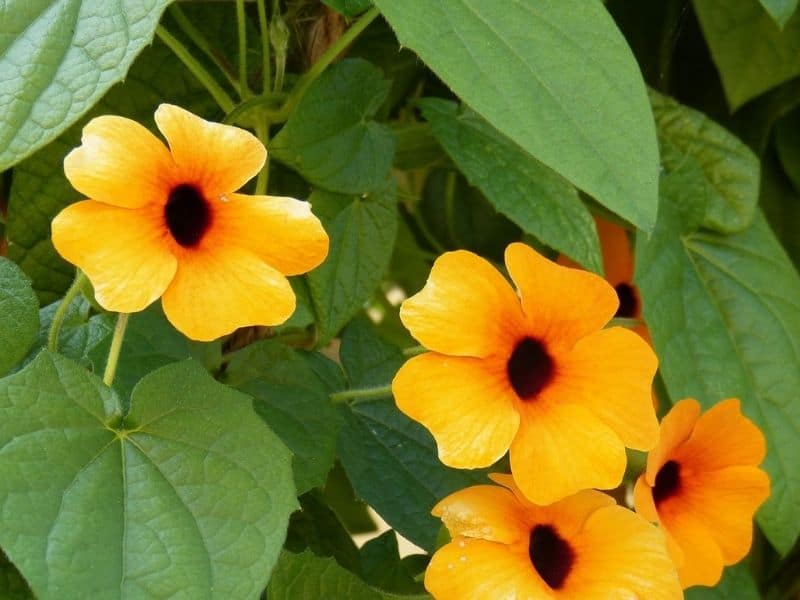
Grow, Care and Maintenance
Sun Requirement
Keeping in mind that the origin of the Black-eyed Vine is in the tropics, it is best planted in spots that get full sun to optimize its growth. Fear not; it could tolerate partial shade, but the blooms will not be as prolific.
Water Requirements
T. alata prefers moderate amounts of moisture, despite it being a sun-loving plant. Make sure to check the moisture content of the soil or make a watering schedule to ensure the vine’s growth is not hindered by the lack or excess water.
Excessive watering will lead to root rot and will make the plant more susceptible to other diseases. On the other hand, watering in too little amounts can cause slower growth or wilt under extreme conditions.
Temperature and Humidity Requirements
In general, the Black-eyed Susan climber loves a warm environment.
When black-eyed Susan vines can’t survive in colder areas, potted plants can be brought inside in late fall (or as soon as the temperature drops below 50 degrees F at night) and grown as a houseplant in a sunny room.
Fertilizer
Generally, this plant survives anywhere without having to apply fertilizer as long as the soil is rich in organic matter. Furthermore, in assisting the vine’s flower production, application of fertilizer that has a 3:1:5 or 2:3:2 N:P:K ratio is beneficial as long as applied in appropriate amounts and occasionally.
Soil Requirements
T. alata prefers growing on well drained soil, such as sandy, clay-loam, and loam soils. In terms of the soil’s pH content, this vine can thrive in soils that are neutral, acid, or alkaline.
However, it is important to note that T. alata does not grow well in soggy soil as it can lead to root rot and other fungal diseases.
Propagation
Pollinators like bees and butterflies see the T. alata vine as an open bar for nectars. These agents help in the development of seeds, which are often harvested as planting material. It is possible to perform other propagation methods like planting stem cuttings and layering but according to studies, vines that are propagated through seed are more prolific.
Soaking the seed in warm water the night before planting will help hasten the germination process. Humus-rich soil combined with sand is the best rooting mixture for the black-eyed Susan vine. If planting in a seedbed, mark the soil giving at least 1.5 x 1.5 inches distance from other seeds. Lightly press the seed towards the soil and cover it with a thin layer of soil and wait for 10 to 21 days for the seed to germinate. Keep the seedbed in a warm area with indirect sunlight.
When seedlings are ready for transplant, providing fences or trellises as support and adding mulch is recommended.
Pruning
Flowering occurs early for the Black-eyed Susan vine. Hence, it is important to schedule regular trimming. Removing dead plant parts will rejuvenate the vine’s aesthetics and prevent pests and diseases. In spring, trimming of leaves aid in the formation of flowers.
During winter, cutting back the vine is recommended to avoid frost damage. However, in frost free climates, cutting back the vine is unnecessary and can be detrimental to the plant’s growth.
Common Pests and Diseases
Some of the common enemies of the Black-eyed Susan vine are caterpillars, spider mites, and whiteflies. The damage is usually overpowered by the plant’s fast growth, making the pest damage negligible. However, if there is an infestation, using pesticides in the right amount and proper time of application is beneficial. Hand-picking and using a soap solution to clean the plant would also help.
Potential Harm
As a fast-growing perennial vine, T. alata can cause serious damage in different landscapes if left unsupervised. It will be a strong competitor and a parasite for some existing vegetations if it is widespread. To avoid situations like this, sticking to a pruning schedule or having a maintenance activity calendar is recommended. Hand weeding or application of herbicides are commonly done to eradicate the annual flowering vine in areas it is not wanted.
Landscape Uses
The black-eyed Susan is an ideal plant for vertical landscapes because it grows fast, comes in various colors, and requires minimal input and maintenance.
In landscapes, this tender perennial is commonly seen crawling and twining around arches, pillars, fences, trellises, and walls. Some plant it in hanging baskets and let it hang in front of their porch. The black-eyed Susan can also serve as ground covers or to cover dead trees.
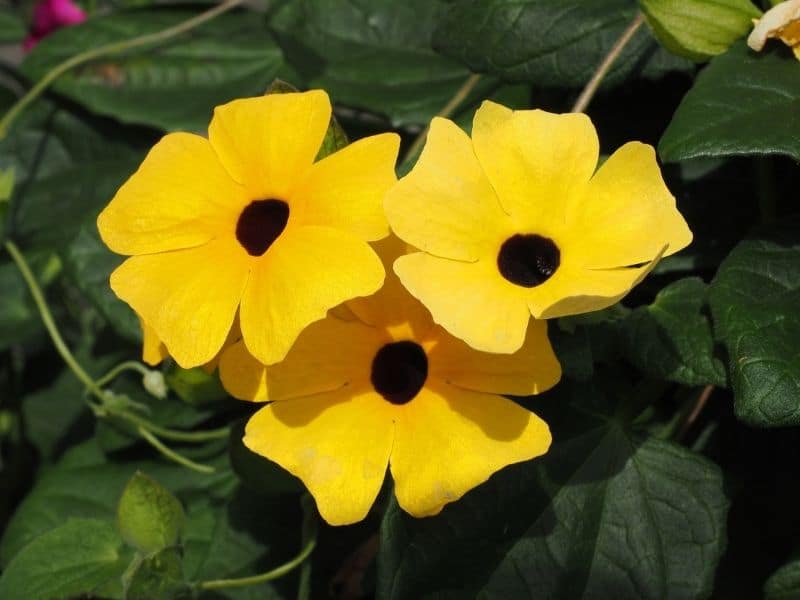
Identifying Common Varieties
Aside from the vine’s functionality, its appearance and aesthetic appeal can be tweaked by picking the right variety. Here are some of the common varieties of the Black-eyed Susan Vine and their distinct characteristics.
‘Susie Mix’
Thunbergia alata ‘Susie Mix’ gives off flowers that are white, yellow or orange in color. Its flower may or may not have a high-contrasting eye.
‘Spanish Eyes’
Thunbergia alata ‘Spanish Eyes’ have distinct flowers with contrasting eyes and subtle shades of terracotta, rose, ivory, apricot, and salmon.
‘Superstar Orange’
From its name, Thunbergia alata ‘Superstar Orange’ produces flowers that will surely make you have a second look. It is distinguished by its extremely huge bright orange flowers.
‘Arizona Dark Red’
Thunbergia alata ‘Arizona Dark Red’ is characterized by having strong red-orange flowers.
‘African Sunset’
Thunbergia alata ‘African Sunset’ blooms flowers that are pale yellowish-white to brick red in color.
‘Blushing Susie’
Thunbergia alata ‘Blushing Susie’ blooms flowers in either rose or apricot shades with dark-colored eyes.
‘Bright Eyes’
Thunbergia alata ‘Bright Eyes’ blooms all white flowers.
‘Orange A-Peel®’
Bright orange petals and dark eyes are the characteristics of the flowers produced by Thunbergia alata ‘Orange A-Peel ®’
‘Lemon A-Peel®’
Thunbergia alata ‘Lemon A-Peel ®’ gives bright colored yellow flowers with a contrasting very dark eye.
‘Canary Eyes’
Thunbergia alata ‘Canary Eyes’ blooms flowers with yellow petals and black eyes.
‘Raspberry Smoothie’
Thunbergia alata ‘Raspberry Smoothie’ has a distinct grayish-green leaves and lilac-pink flowers
‘Orange Wonder’
Thunbergia alata ‘Orange Wonder’ blooms bright orange flowers with dark eyes.
Tips on Choosing the Right Black-eyed Susan Vine for the Landscape
Establishing the garden’s purpose, theme, and presence of existing vegetation and man-made fixtures are the first steps you must do in preparing your landscape design. In choosing the right variety, checking the color and theme of the garden should be considered. For example, the garden is in a rustic style. Choosing the ‘African Sunset’ or ‘Spanish Eyes’ will complement the theme.
In addition to planning your landscape design, remember that the T. alata is a fast grower. This means aside from planning the design, planning the maintenance calendar is recommended. With your acquired knowledge from the information stated above, create a schedule that would fit you and your garden.
FAQs
Why is my black eyed Susan vine dying?
Black Eyed Susan vine may be dying due to various factors such as overwatering, underwatering, insufficient light, or pest infestations. Assess the plant’s environment and care routine to identify and address the specific issue causing its decline.
Why won’t my black eyed Susan vine bloom?
Black Eyed Susan vine may fail to bloom if it’s not receiving enough sunlight, particularly if it’s planted in a location with too much shade. Ensure the plant is getting at least 6 hours of direct sunlight per day to promote flowering.
Will Black Eyed Susan vine self seed?
Yes, Black Eyed Susan vine can self-seed under favorable growing conditions. The plant produces seed pods containing small black seeds that can drop to the ground and germinate, leading to new plants in the vicinity.
Can you grow black-eyed Susan vine from cuttings?
Yes, Black Eyed Susan vine can be propagated from stem cuttings. Take a cutting from a healthy stem, remove the lower leaves, and place the cutting in moist, well-draining soil or a rooting medium. Keep the cutting in a warm, humid environment until roots develop.
Final thoughts
In conclusion, Black Eyed Susan Vine care requires attention to its specific needs, including sunlight, water, and support for climbing. Providing well-draining soil, ample sunlight, and regular watering ensures healthy growth and abundant flowering.
Proper pruning and trellising help maintain its attractive vine-like habit and encourage continuous blooming throughout the growing season. With good care and attention, Black Eyed Susan Vine can be a vibrant and eye-catching addition to any garden or landscape.
*image by alexandrelaprise/depositphotos

